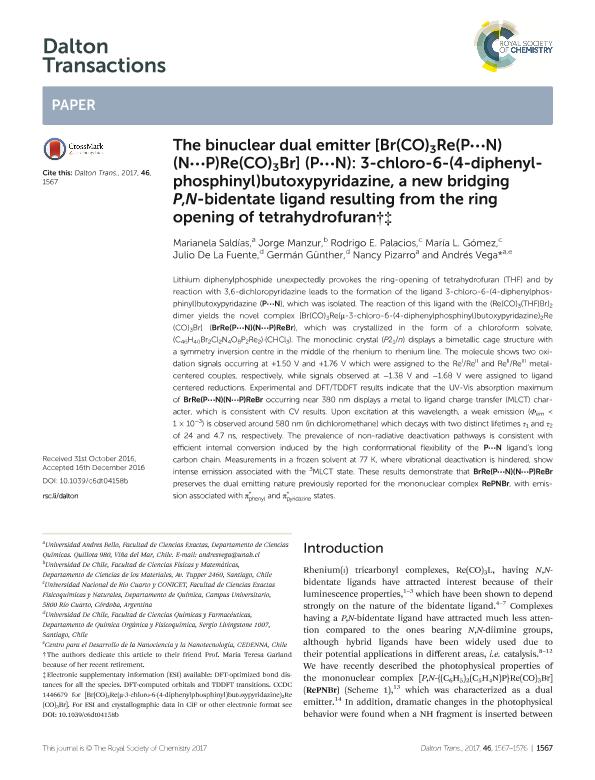Artículo
The binuclear dual emitter [Br(CO)3Re(P⋯N)(N⋯P)Re(CO)3Br] (P⋯N): 3-chloro-6-(4-diphenylphosphinyl)butoxypyridazine, a new bridging P,N-bidentate ligand resulting from the ring opening of tetrahydrofuran
Saldías, Marianela; Manzur, Jorge; Palacios, Rodrigo Emiliano ; Gomez, María Lorena
; Gomez, María Lorena ; de la Fuente, Julio; Günther, Germán; Pizarro, Nancy; Vega, Andrés
; de la Fuente, Julio; Günther, Germán; Pizarro, Nancy; Vega, Andrés
 ; Gomez, María Lorena
; Gomez, María Lorena ; de la Fuente, Julio; Günther, Germán; Pizarro, Nancy; Vega, Andrés
; de la Fuente, Julio; Günther, Germán; Pizarro, Nancy; Vega, Andrés
Fecha de publicación:
01/2017
Editorial:
Royal Society of Chemistry
Revista:
Dalton Transactions
ISSN:
1477-9226
Idioma:
Inglés
Tipo de recurso:
Artículo publicado
Clasificación temática:
Resumen
Lithium diphenylphosphide unexpectedly provokes the ring-opening of tetrahydrofuran (THF) and by reaction with 3,6-dichloropyridazine leads to the formation of the ligand 3-chloro-6-(4-diphenylphosphinyl)butoxypyridazine (P⋯N), which was isolated. The reaction of this ligand with the (Re(CO)3(THF)Br)2 dimer yields the novel complex [Br(CO)3Re(μ-3-chloro-6-(4-diphenylphosphinyl)butoxypyridazine)2Re (CO)3Br] (BrRe(P⋯N)(N⋯P)ReBr), which was crystallized in the form of a chloroform solvate, (C46H40Br2Cl2N4O8P2Re2)·(CHCl3). The monoclinic crystal (P21/n) displays a bimetallic cage structure with a symmetry inversion centre in the middle of the rhenium to rhenium line. The molecule shows two oxidation signals occurring at +1.50 V and +1.76 V which were assigned to the ReI /ReII and ReII/ReIII metalcentered couples, respectively, while signals observed at −1.38 V and −1.68 V were assigned to ligand centered reductions. Experimental and DFT/TDDFT results indicate that the UV-Vis absorption maximum of BrRe(P⋯N)(N⋯P)ReBr occurring near 380 nm displays a metal to ligand charge transfer (MLCT) character, which is consistent with CV results. Upon excitation at this wavelength, a weak emission (Φem < 1 × 10−3 ) is observed around 580 nm (in dichloromethane) which decays with two distinct lifetimes τ1 and τ2 of 24 and 4.7 ns, respectively. The prevalence of non-radiative deactivation pathways is consistent with efficient internal conversion induced by the high conformational flexibility of the P⋯N ligand’s long carbon chain. Measurements in a frozen solvent at 77 K, where vibrational deactivation is hindered, show intense emission associated with the 3 MLCT state. These results demonstrate that BrRe(P⋯N)(N⋯P)ReBr preserves the dual emitting nature previously reported for the mononuclear complex RePNBr, with emission associated with π* phenyl and π* pyridazine states.
Palabras clave:
Rhenium Complexes
,
Metal to Ligand Charge Transfer
,
Emission
Archivos asociados
Licencia
Identificadores
Colecciones
Articulos(CCT - CORDOBA)
Articulos de CTRO.CIENTIFICO TECNOL.CONICET - CORDOBA
Articulos de CTRO.CIENTIFICO TECNOL.CONICET - CORDOBA
Citación
Saldías, Marianela; Manzur, Jorge; Palacios, Rodrigo Emiliano; Gomez, María Lorena; de la Fuente, Julio; et al.; The binuclear dual emitter [Br(CO)3Re(P⋯N)(N⋯P)Re(CO)3Br] (P⋯N): 3-chloro-6-(4-diphenylphosphinyl)butoxypyridazine, a new bridging P,N-bidentate ligand resulting from the ring opening of tetrahydrofuran; Royal Society of Chemistry; Dalton Transactions; 46; 5; 1-2017; 1567-1576
Compartir
Altmétricas



